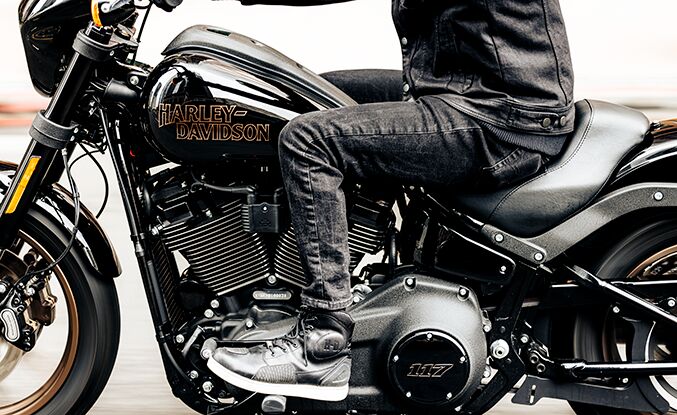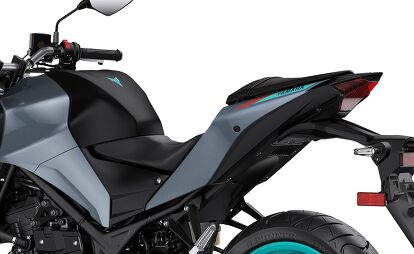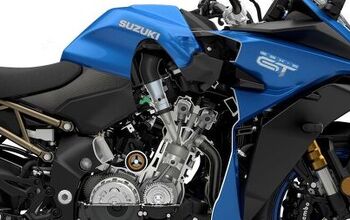Ask MO Anything: Gas Tanks and Pelvic Injuries
It concerns more than just your male and female parts
Hi MO,
I’m thinking about getting a motorcycle again (had a 1973 CB500 four back in the day) because my 74- year old knees and ankles aren’t up to bicycling anymore.
I’ve been doing a lot of reading, comparing specs, etc., and I stumbled on an article from a few years back about a study on high gas tanks and the risk of serious damage to male genitals. So looking again at some of the bikes I’ve been considering I see that they do indeed have high gas tanks where this could be an issue (Yamaha MT03, Honda CB300R, Kawasaki Z400…).
I once rode a Strida folding bicycle and dismounting was very painful if you weren’t careful (no leaning forward when getting off). I can imagine the same issue with these tanks.
Two questions: Is this much of an issue on daily use, like something you have to be aware of constantly, and, knowing this can be very dangerous, why do you think manufacturers continue designing them this way?
A cautious old man
Dear Cautious,
Although pelvic injuries should not occupy the top of your list of injury concerns, they do happen often enough to merit some thought. Fractures of the lower extremities, for example, are much more common, and head injuries are even more serious and devastating. You can’t do much to protect yourself from serious leg fractures, but a helmet that meets one of the standards – DOT, EU, etc. – can cut your brain-injury risk by two-thirds.
Nonetheless, over the years, gas tank designers and accessory makers have come up with some truly short-sighted designs and features.
Perhaps the most horrifying was the “racing-style” flip-open gas cap design of the 1960s and early 1970s, in particular, those that hinged at the front. In a head-on collision that caused the rider to slide forward along the top of the tank, the likely scenario was that as he (since you ask about the effects on men) slid forward, the rider’s nether bits would first encounter the release latch, causing the gas cap to spring open. That vertical gas cap then became a very effective castration tool. The open fuel filler could also provide a quick splash of gasoline on the rider’s crotch, leading to a memorable weenie roast. Fortunately, attorneys quickly brought the shortcomings, er… drawbacks of this design to motorcycle makers’ collective attention, and it isn’t used on OEM equipment any longer. However, some filler necks still protrude above the top of the tank, which may reduce your chances of fatherhood. The flush tank-top fuel filler isn’t merely for style.
Another real gonad-grabber was the tank-top parcel rack, which was available on a few bikes until the dangers it posed became apparent. As early as 1968, Peter Bothwell’s “Motor Cycle Crash Tests” research for the Jim Clark Foundation expressed concern: “These are not trivial cases of injury as they can be responsible for such injuries as amputation of the male sex organs…” Worse, Bothwell pointed out, was the dangerous stuff that was often attached to these racks. In particular, police often mounted radios on these luggage racks.
Even if you want to carry things atop your tank, what Bothwell termed “appalling and lethal clutter on the tank top” is not needed. No rack is required to bungee a sleeping bag to the top of the tank, for example, but don’t strap something solid up there.
According to more recent studies, somewhere around 15% to 25% of riders who are hospitalized seem to suffer pelvic injuries, and a large majority (85% to 95%) of those injuries are caused by contact with the gas tank. The injuries range from lightly bashed boy bits and those that make you walk funny for a few days to really ugly stuff like fractures of the pelvic ring and damage to the bladder and other internal organs. Researching this article, unfortunately, informed me about “open-book” injuries, where the pubic bone is split open like a book.
The reason for large gas tanks is obvious: range. To create a bigger tank, the maker generally needs to make it wider and/or taller. Both involve compromises. If you don’t mind having to stop for fuel every 50 miles or so, it would be easy to get the tank out of your way. Putting the gas tank under the seat removes it from the ejection path, but that usually means that something else has to occupy that same space.
My initial assumption was that gas-tank shape and size would be the primary factor in pelvic injuries, but that turns out to be just one factor, though probably the most significant one.
If the rear of the fuel tank is tall and nearly vertical — as on many sportbikes — consider what the first thing to slam into that surface is likely to be when you, for example, T-bone an SUV. Sure enough, a 2014 Australian study found that “the likelihood of pelvic / abdominal injuries significantly increased with increasing petrol tank angle.” A 2006 study at the University of California agreed: “Injury potential is increased for the pelvis as the vertical angle of the gas tank is increased as well as increased Delta-Vs… The average pelvic force increased exponentially (R2 > .99) as the gas tank angle increased.” (Delta-V is the change of velocity in an impact.) As far as I know, no one has studied what effect, if any, those softer plastic aftermarket tanks for dirt bikes might have on pelvic injuries.
You might therefore assume that the moderately sloped tops of typical cruiser tanks would be less likely to injure you than those vertical sporty tanks. That seems to be mostly true. But it doesn’t take into consideration rider posture. A cruiser rider usually has his or her feet forward, a lot of weight on his butt, his hands high, his legs slightly splayed, and his back vertical. When combined with the greater rearward weight bias of a cruiser – which will reduce the motorcycle’s tendency to pitch forward stoppie-style – this position is less likely to pitch the rider up and over the fuel tank and more likely to slide him into it… crotch-first. (That is before you consider the braking capabilities of the two types of bikes and the braking skills of their riders. Or even if they brake at all. Reduced braking before an impact will yield a harder impact.)
In contrast, the sportbike posture – feet under the rider, torso canted forward so that much of the rider’s weight is on his hands and arms – would appear to lead to the bike diving more, making the rider more likely to be pitched upward a bit, possibly clearing the gas tank. Having his feet under him also makes it easier to push off, allowing him to stand so his crotch is above the fuel tank before impact. With warning, the rider might even be able to jump, to help him go over a low vehicle. There are plenty of tales of riders jumping as they collide and thereby clearing the car they hit. Such a jump could also preclude the possibility of goodies and gas tanks getting together.
Of course, even if you clear the fuel tank, there are all sorts of hazards waiting to hurt you beyond it in a frontal crash – handlebar, fork crown, fairing, and windshield. Then you encounter the vehicle or other object that you collided with. But the worst may still be to come – all that dangerous stuff lining the road. Government and road-safety sorts in the U.S. have given virtually no attention to the hazards that roadside “furniture” poses to motorcyclists. The “Safe Streets” initiatives you hear about benefit bicyclists and pedestrians, but injuries to motorcyclists are ignored.
So, if pelvic injuries concern you, beyond considering the gas tank, you might want to add a groin guard to your protective apparel, but don’t forget the rest of your protective gear either. If you whack your head without a good helmet and transition from animal to vegetable, I promise you won’t care about your groin.
Oh, and I own a Strida folding bicycle. I’ve never experienced any discomfort when mounting or dismounting.
—Art Friedman
Art Friedman is a former editor of Cycle News, Motorcycle Cruiser, and Motorcyclist magazines and was the Editor / Principal Investigator for the National Agenda for Motorcycle Safety, a joint project of the National Highway Traffic Safety Administration and the Motorcycle Safety Foundation. He has ridden over 1.5 million miles on thousands of motorcycles. He may even have crashed once or twice.
Become a Motorcycle.com insider. Get the latest motorcycle news first by subscribing to our newsletter here.
More by Art Friedman








































Comments
Join the conversation
"There are plenty of tales of riders jumping as they collide and thereby clearing the car they hit." Those stories sound as truthful as the guys that claim they "had to lay the bike down" before they hit something. No, you panic braked and that threw you on the ground. I'm betting the guess that claim they "jumped" were more likely thrown by the luck of the drawn.
I think Harley tanks would be safer in certain cases because the seat to tank transition is smoother than something like a sport bike where you basically run into a wall.
Also, I think riding positions of some motorcycles, ridden long term, can cause medical conditions without having an accident.
I seriously hope the motorcycle industry NEVER designs motorcycles for safety first. They will look like a 2-wheeled Toyota Camry. No thanks!
None of these danger scenarios apply to riders with balls of steel.